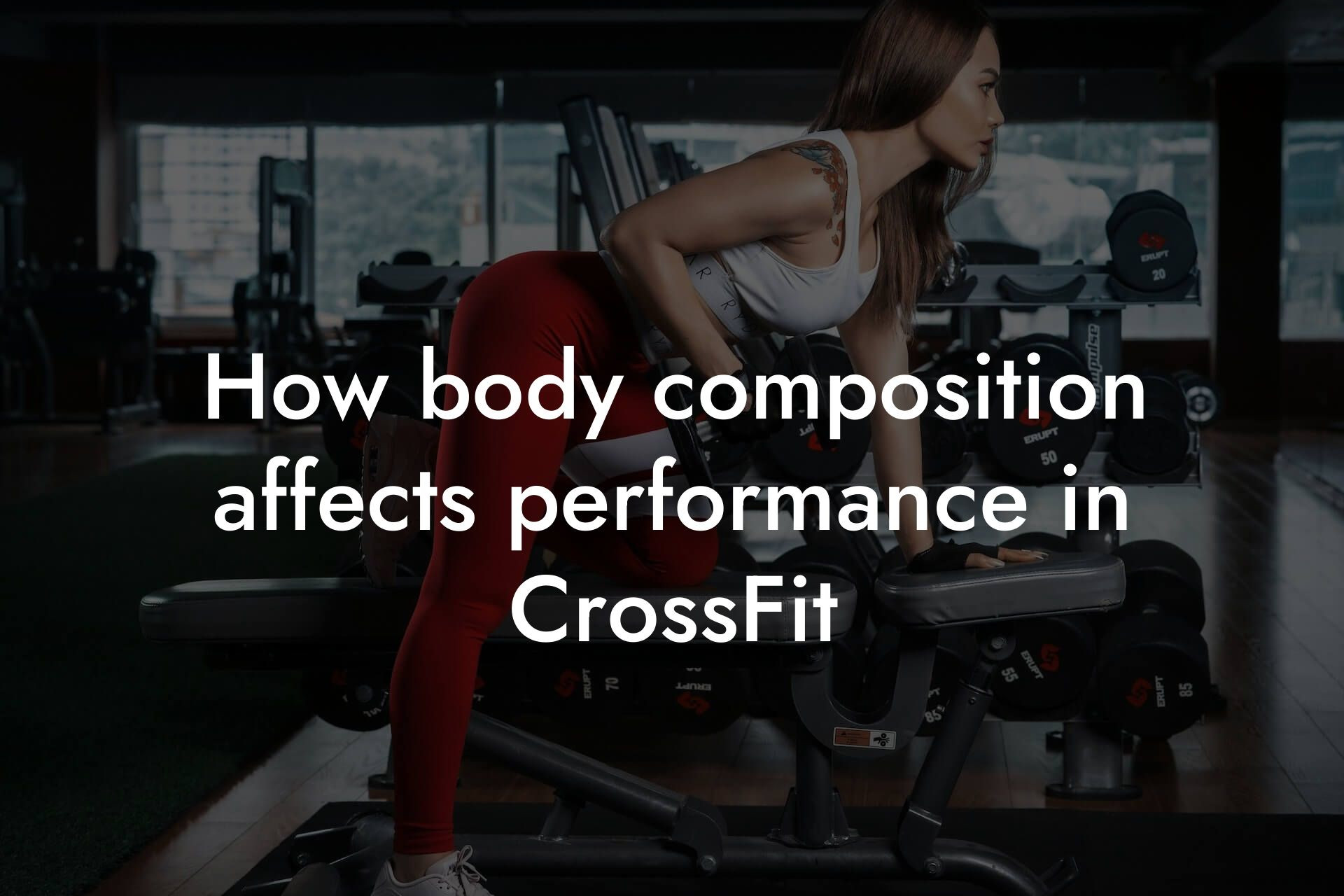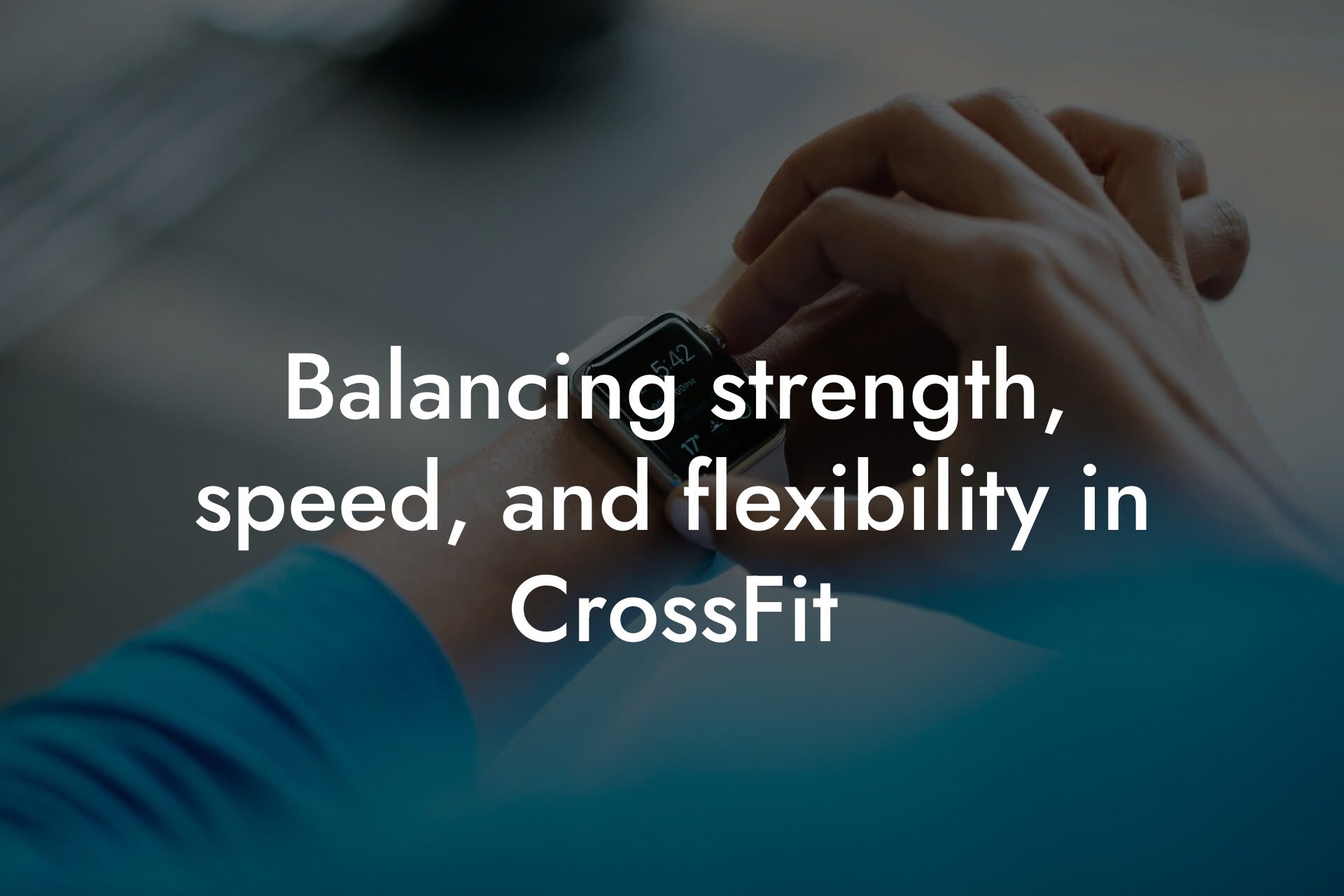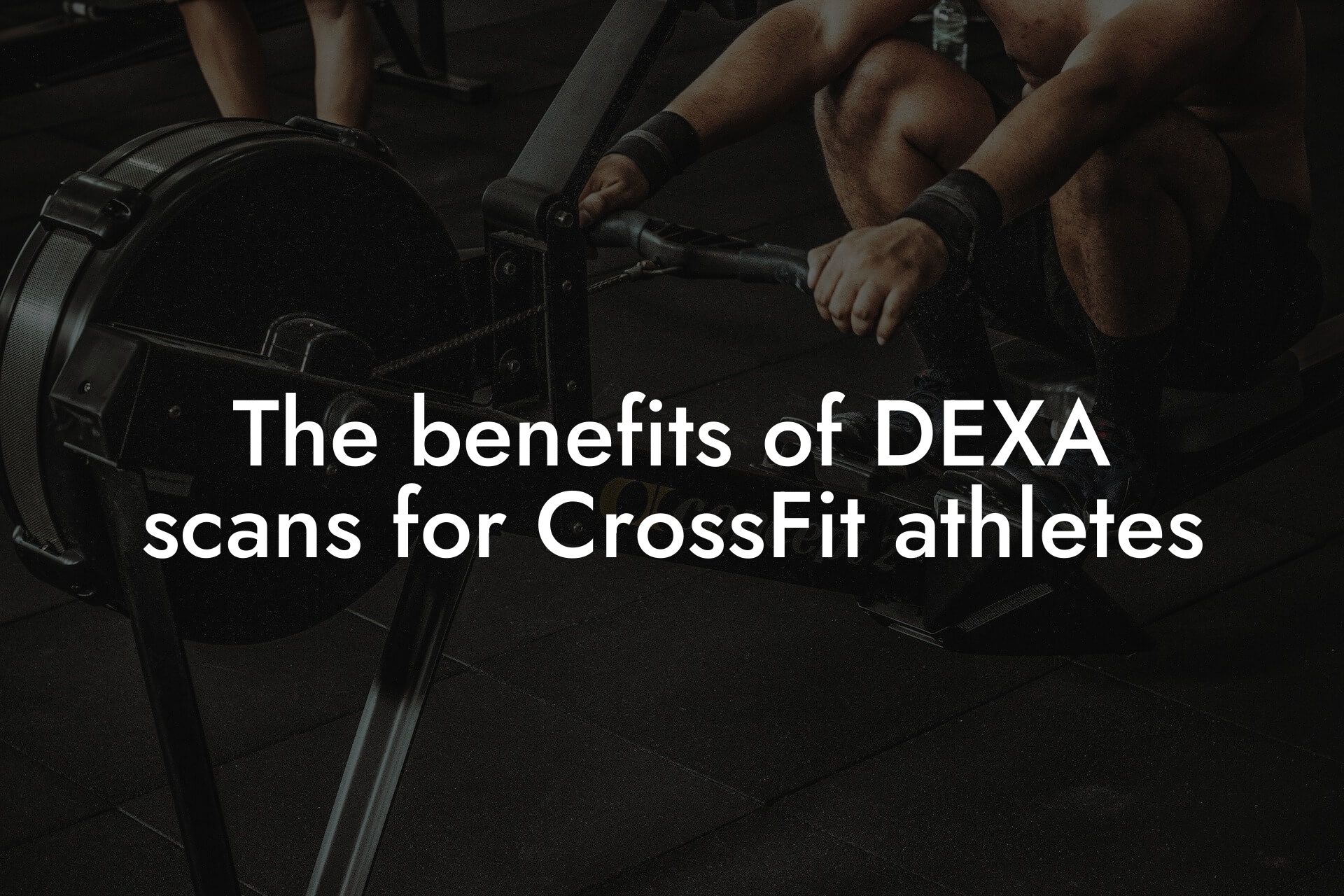As a high-earning professional, you understand the importance of maintaining a healthy and fit physique. When it comes to CrossFit competitions, having a low body fat percentage is crucial for optimal performance. Excess body fat can hinder your ability to perform at your best, making it essential to focus on reducing body fat to achieve success in the sport. In this article, we will delve into the importance of reducing body fat for CrossFit competitions and provide you with a comprehensive guide on how to achieve your goals.
Table of Contents
- The Impact of Body Fat on CrossFit Performance
- The Ideal Body Fat Percentage for CrossFit Athletes
- Macronutrient Balancing for Fat Loss
- Incorporating Strength Training for Fat Loss
- High-Intensity Interval Training (HIIT) for Fat Loss
- Active Recovery and Rest for Fat Loss
- Monitoring Progress and Adjusting Your Plan
- Frequently Asked Questions
The Impact of Body Fat on CrossFit Performance
Body fat plays a significant role in CrossFit performance. Excess body fat can increase your overall weight, making it more challenging to perform movements that require strength, power, and endurance. Additionally, excess body fat can also affect your mobility, flexibility, and agility, making it more difficult to execute complex movements and transitions. Furthermore, high body fat percentages can also lead to decreased endurance and stamina, making it challenging to complete high-intensity workouts and competitions.
The Ideal Body Fat Percentage for CrossFit Athletes
So, what is the ideal body fat percentage for CrossFit athletes? The American Council on Exercise (ACE) recommends that male CrossFit athletes aim for a body fat percentage between 6-13%, while female athletes should aim for a body fat percentage between 16-23%. However, these are general guidelines, and the ideal body fat percentage may vary depending on individual goals and needs. At Tano Performance Group, we use DEXA machine technology to provide a complete body assessment, helping you determine your ideal body fat percentage and create a personalized plan to achieve your goals.
Macronutrient Balancing for Fat Loss
Macronutrient balancing is a critical component of reducing body fat for CrossFit competitions. To lose body fat, you need to create a calorie deficit by consuming fewer calories than your body burns. However, it's essential to ensure that you're getting the right balance of macronutrients to support your training and recovery. Aim to consume a balanced diet that includes:
- 1.6-2.2 grams of protein per kilogram of body weight to support muscle growth and repair
- 2-3 grams of complex carbohydrates per kilogram of body weight to provide energy for your workouts
- 0.5-1 gram of healthy fats per kilogram of body weight to support hormone production and overall health
Additionally, make sure to stay hydrated by drinking plenty of water throughout the day.
Incorporating Strength Training for Fat Loss
Strength training is a crucial component of reducing body fat for CrossFit competitions. By building muscle mass, you'll increase your resting metabolic rate, helping your body burn more calories at rest. Focus on incorporating compound exercises such as squats, deadlifts, and bench press into your training program. These exercises will help you build muscle mass and increase your overall strength and power.
High-Intensity Interval Training (HIIT) for Fat Loss
HIIT is a highly effective way to burn fat and improve cardiovascular fitness. By incorporating HIIT workouts into your training program, you'll be able to burn a high number of calories in a short amount of time. Aim to incorporate HIIT workouts 2-3 times per week, focusing on exercises such as sprints, burpees, and jump squats.
Active Recovery and Rest for Fat Loss
Active recovery and rest are critical components of reducing body fat for CrossFit competitions. By incorporating low-intensity activities such as yoga, walking, or cycling into your training program, you'll be able to aid in recovery and reduce muscle soreness. Additionally, make sure to get 7-9 hours of sleep per night to aid in recovery and muscle growth.
Monitoring Progress and Adjusting Your Plan
Monitoring progress is essential when it comes to reducing body fat for CrossFit competitions. By tracking your body fat percentage, weight, and measurements, you'll be able to see how your diet and training program are affecting your body. Use this information to adjust your plan, making changes to your diet and training program as needed. At Tano Performance Group, we use DEXA machine technology to provide a complete body assessment, helping you track your progress and make data-driven decisions.
Reducing body fat for CrossFit competitions requires a combination of proper nutrition, strength training, HIIT, and active recovery. By following the tips outlined in this article, you'll be able to create a personalized plan to help you achieve your goals. Remember to stay consistent, patient, and persistent, and don't be afraid to seek help from a qualified coach or nutritionist. At Tano Performance Group, we're committed to helping you achieve your goals and take your performance to the next level.
Frequently Asked Questions
What is the ideal body fat percentage for CrossFit athletes?
For CrossFit athletes, the ideal body fat percentage varies depending on the individual's goals and performance requirements. Generally, a body fat percentage between 6-13% for men and 16-23% for women is considered optimal for performance and aesthetics. However, this range can vary depending on factors such as muscle mass, bone density, and overall health.
Why is reducing body fat important for CrossFit performance?
Reducing body fat is essential for CrossFit performance because it allows for improved power-to-weight ratio, increased endurance, and enhanced overall athleticism. Excess body fat can hinder performance by increasing energy expenditure, reducing speed and agility, and making movements more challenging.
How does body fat affect my CrossFit performance?
Body fat can affect CrossFit performance in several ways, including reduced power output, decreased endurance, and increased risk of injury. Excess body fat can also lead to decreased mobility, reduced flexibility, and impaired recovery. By reducing body fat, athletes can improve their overall performance and reduce their risk of injury.
What are the benefits of reducing body fat for CrossFit athletes?
The benefits of reducing body fat for CrossFit athletes include improved performance, increased confidence, and enhanced overall health. Reducing body fat can also lead to improved body composition, increased muscle mass, and a reduced risk of chronic diseases such as diabetes and heart disease.
How can I measure my body fat percentage?
There are several ways to measure body fat percentage, including dual-energy X-ray absorptiometry (DXA), hydrostatic weighing, and skinfold measurements. However, the most common method is bioelectrical impedance analysis (BIA), which uses a device to send an electrical current through the body to estimate body fat percentage.
What is the best way to reduce body fat for CrossFit performance?
The best way to reduce body fat for CrossFit performance is through a combination of proper nutrition, consistent training, and sufficient recovery. This includes eating a balanced diet with adequate protein, healthy fats, and complex carbohydrates, while also incorporating strength training, high-intensity interval training (HIIT), and active recovery techniques.
What role does nutrition play in reducing body fat for CrossFit athletes?
Nutrition plays a critical role in reducing body fat for CrossFit athletes. A balanced diet that is high in protein, healthy fats, and complex carbohydrates can help support muscle growth and recovery, while also promoting fat loss. Additionally, adequate hydration and electrolyte balance are essential for optimal performance and recovery.
How many calories should I consume to reduce body fat for CrossFit performance?
The ideal caloric intake for reducing body fat for CrossFit performance varies depending on the individual's goals, activity level, and body composition. Generally, a caloric deficit of 500-1000 calories per day is recommended for safe and sustainable fat loss. However, it's essential to consult with a registered dietitian or nutritionist to determine the ideal caloric intake for your specific needs.
What are the best foods for reducing body fat for CrossFit athletes?
The best foods for reducing body fat for CrossFit athletes include lean protein sources such as chicken, fish, and turkey, healthy fats like avocado and nuts, and complex carbohydrates like sweet potatoes and brown rice. Additionally, foods high in fiber like fruits and vegetables can help support digestive health and satiety.
How can I incorporate strength training into my CrossFit routine to reduce body fat?
Incorporating strength training into your CrossFit routine can help reduce body fat by building muscle mass and increasing metabolism. Focus on exercises that work multiple muscle groups at once, such as squats, deadlifts, and bench press, and aim to complete 2-3 strength training sessions per week.
What is the role of high-intensity interval training (HIIT) in reducing body fat for CrossFit athletes?
HIIT plays a critical role in reducing body fat for CrossFit athletes by improving cardiovascular fitness, increasing caloric expenditure, and enhancing insulin sensitivity. Incorporate HIIT workouts 2-3 times per week, focusing on exercises like sprints, burpees, and jump squats.
How can I incorporate active recovery techniques into my CrossFit routine to reduce body fat?
Incorporating active recovery techniques like yoga, stretching, and foam rolling can help reduce body fat by improving flexibility, reducing inflammation, and enhancing recovery. Aim to complete 1-2 active recovery sessions per week, focusing on exercises that target specific muscle groups.
What is the importance of sleep and recovery in reducing body fat for CrossFit athletes?
Sleep and recovery are essential for reducing body fat for CrossFit athletes, as they allow the body to repair and adapt to the demands of training. Aim for 7-9 hours of sleep per night and prioritize rest days and active recovery techniques to support optimal recovery.
How can I track my progress and stay motivated during my body fat reduction journey?
Tracking progress and staying motivated are crucial for success in reducing body fat for CrossFit performance. Use tools like body fat calipers, progress photos, and workout logs to track progress, and set realistic goals and rewards to stay motivated.
What are some common mistakes CrossFit athletes make when trying to reduce body fat?
Common mistakes CrossFit athletes make when trying to reduce body fat include overtraining, undereating, and neglecting recovery. Additionally, focusing too much on aesthetics rather than performance and neglecting overall health and wellness can also hinder progress.
How long does it take to see results from reducing body fat for CrossFit performance?
The time it takes to see results from reducing body fat for CrossFit performance varies depending on the individual's starting point, training, and nutrition. However, with consistent effort and patience, most athletes can expect to see noticeable improvements in 6-12 weeks.
What are the risks of extreme body fat reduction for CrossFit athletes?
Extreme body fat reduction can lead to risks such as malnutrition, decreased performance, and increased risk of injury. Additionally, extreme caloric restriction can lead to hormonal imbalances, decreased bone density, and other negative health consequences.
How can I maintain my body fat percentage once I've reached my goal?
Maintaining body fat percentage requires continued focus on proper nutrition, consistent training, and sufficient recovery. Additionally, regular progress tracking and adjustments to training and nutrition as needed can help ensure continued progress and maintenance of optimal body composition.
What role does mental preparation play in reducing body fat for CrossFit athletes?
Mental preparation plays a critical role in reducing body fat for CrossFit athletes, as it helps build confidence, motivation, and resilience. Focus on developing a growth mindset, setting realistic goals, and practicing positive self-talk to support mental preparation and overall success.
How can I get support and accountability during my body fat reduction journey?
Getting support and accountability is essential for success in reducing body fat for CrossFit performance. Consider working with a coach, joining a community or support group, or finding a workout buddy to provide motivation and guidance throughout your journey.
What are some common myths about reducing body fat for CrossFit athletes?
Common myths about reducing body fat for CrossFit athletes include the idea that low-carb diets are necessary for fat loss, that cardio is the best way to burn fat, and that extreme caloric restriction is required for rapid fat loss. However, these myths can be debunked by focusing on balanced nutrition, consistent training, and sufficient recovery.
How can I balance reducing body fat with other fitness goals, such as building muscle or increasing endurance?
Balancing reducing body fat with other fitness goals requires a holistic approach to training and nutrition. Focus on building muscle through strength training, increasing endurance through cardio and HIIT, and prioritizing balanced nutrition to support overall fitness goals.
Here are some related articles you might love...
- How body composition affects performance in CrossFit
- Balancing strength, speed, and flexibility in CrossFit
- The benefits of DEXA scans for CrossFit athletes
- Nutrition tips for sustaining energy during CrossFit workouts
- Recovery techniques for CrossFit athletes after intense WODs
- The role of muscle mass in CrossFit endurance and power
- Off-season training strategies for CrossFit athletes
- Bone density and injury prevention in CrossFit
- Strength and conditioning programs for CrossFit athletes
Zak Faulkner
Zak Faulkner is a leading authority in the realm of physical health and body composition analysis, with over 15 years of experience helping professionals optimise their fitness and well-being. As one the experts behind Tano Performance Group, Zak has dedicated his career to providing in-depth, science-backed insights that empower clients to elevate their physical performance and overall health.
With extensive knowledge of DEXA technology, Zak specializes in delivering comprehensive body assessments that offer precise data on body fat, muscle mass, bone density, and overall physique. His expertise enables individuals to make informed decisions and achieve their fitness goals with accuracy and confidence. Zak’s approach is rooted in a deep understanding of human physiology, combined with a passion for helping clients unlock their full potential through personalised strategies.
Over the years, Zak has earned a reputation for his commitment to excellence, precision, and client-focused service. His guidance is trusted by top professionals who demand the best when it comes to their health. Whether advising on fitness programs, nutritional strategies, or long-term wellness plans, Zak Faulkner’s insights are a valuable resource for anyone serious about taking their health and fitness to the next level.
At Tano Performance Group, Zak continues to lead our Content Team revolutionising how professionals approach their physical health, offering unparalleled expertise that drives real results.




